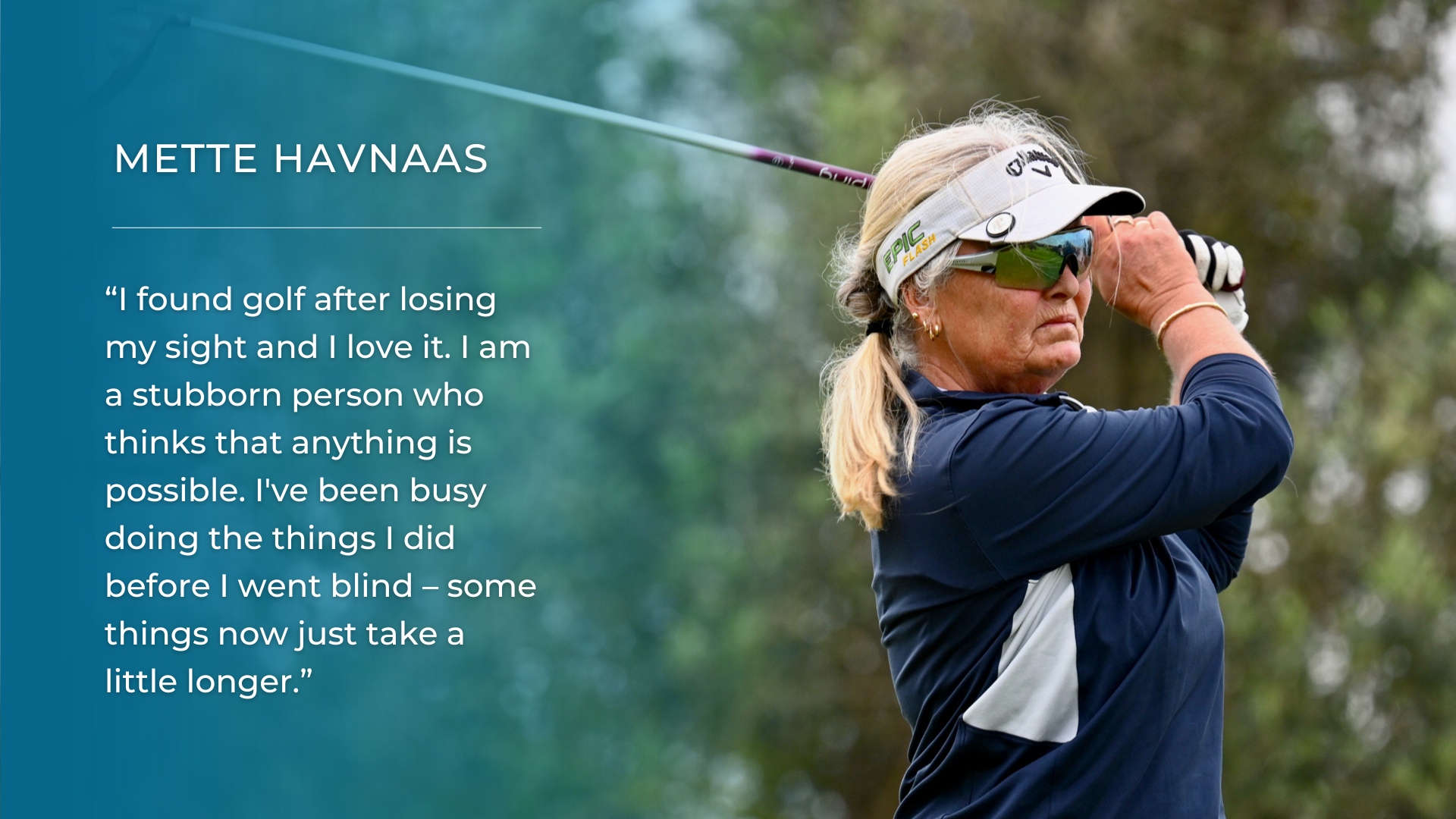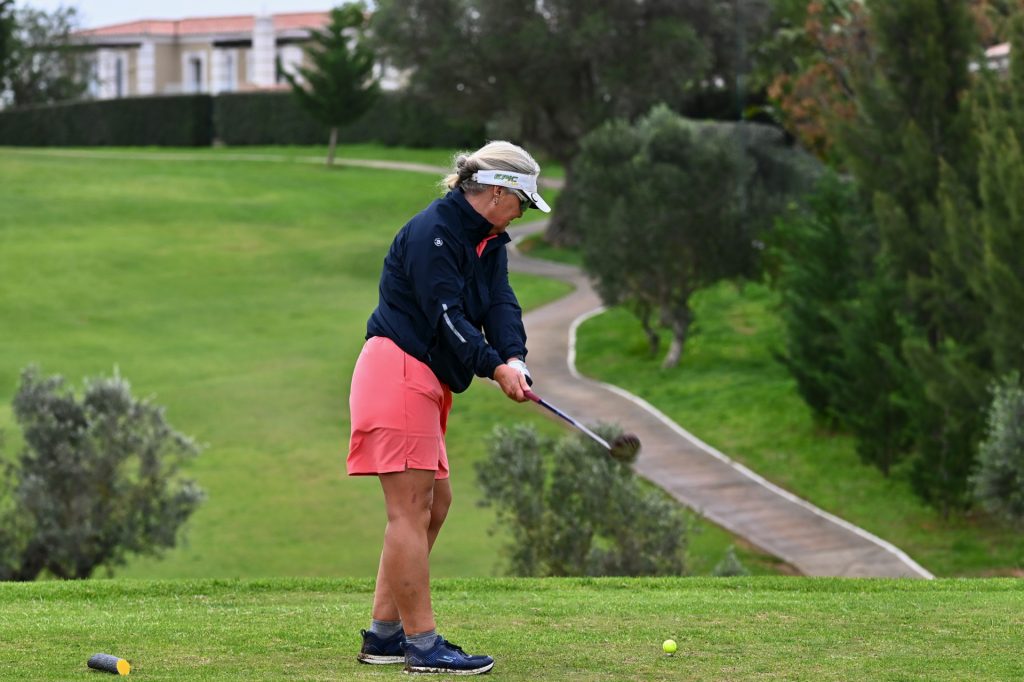
Norway’s Mette Havnaas hears when she plays a good shot, she doesn’t see it. ‘Top notch’ is how she describes the sound when a putt has fallen to the bottom of the cup.
It takes courage for someone who has lost their sight as an adult to learn a completely new sport as Mette has done, and then to travel to different European venues to play in tournaments.
Central to her giving this interview Mette wanted to make other people with visual impairment aware that golf can be a game for them. At ‘G4D’ (golf for the disabled) events and ‘regular’ competitions, Mette is now a standard bearer in this area. We said hello to Mette, and her guide/companion and husband, Birger, on the Algarve in Portugal when she was playing in the second of her first two EDGA tournaments outside of her home country (Mette has also played G4D events in Spain and Sweden, since she played her first tournament in 2022).
Mette and Birger have needed their courage – the couple hiked in the Himalayas in 2019, trusting each other not to lose their footing on the rocky trails beside treacherous ravines. Mette was walking without a left eye, and she sees only contrasts, shadows and bright light with her right eye. Imagine then the pair of them climbing to the Annapurna base camp at 4,130 metres in Nepal: it was a triumph, and a relief.
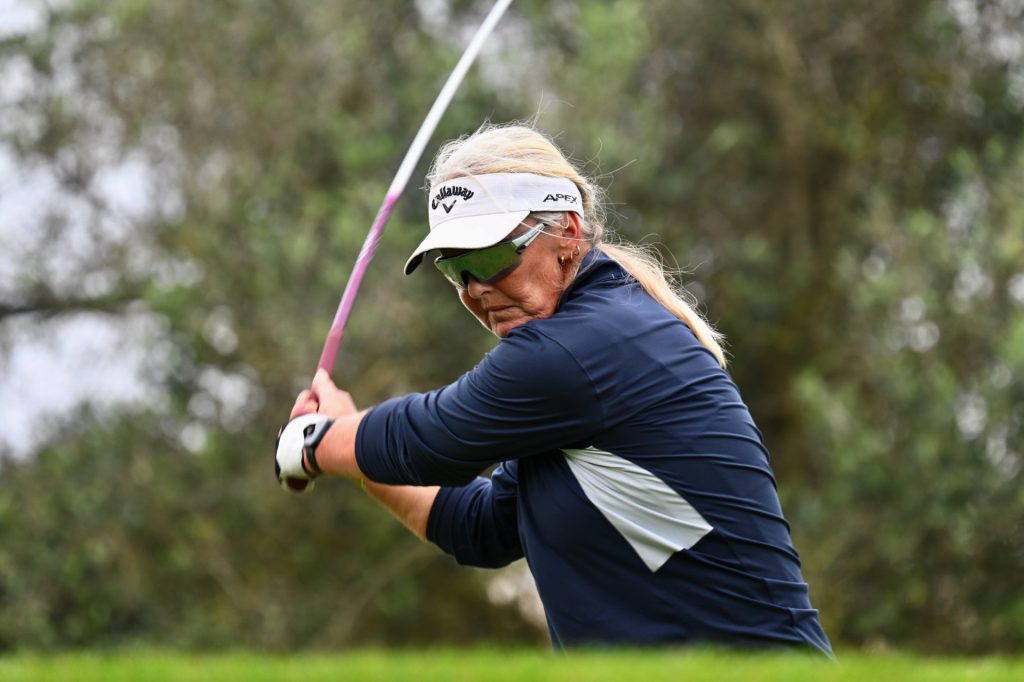
Courage to face a changing life. Standing on a tee knowing that people are watching, or coping with gusts of wind on a mountain path, are perhaps nothing compared with the decision Mette took after suffering for years with pain that was destroying her life.
In 1996, with Mette and Birger bringing up their sons Simen and Sander, life was going great for the active and positive 27 year-old Mette, living near the town of Sandefjord, Vestfold county, in the south of Norway. For Mum, it was a joy to watch the boys growing up.
One night Mette was feeling unwell with flu-like symptoms and she took four pain killing tablets over two evenings to help her sleep. On the third day she had a skin rash and on the next day was admitted to hospital. Along with major issues with the condition of her skin on her body (Mette says she resembled a burns victim), her sinuses and her eyes were attacked by the skin infection; around the eyes blisters ravaged her skin and the tear fluid we all need stopped working completely. Pain became the constant companion, it would be so for seven years as various treatments were tried. The corneal inflammation effectively spoiled day to day life for Mette. She would lie in a darkened room for days, at rock bottom.
Out of the blue, Mette became one of the – more or less – one-in-a-million people who contract Stevens-Johnson syndrome every year in this part of Europe, an autoimmune skin reaction typically caused by the body rebelling against a medication.
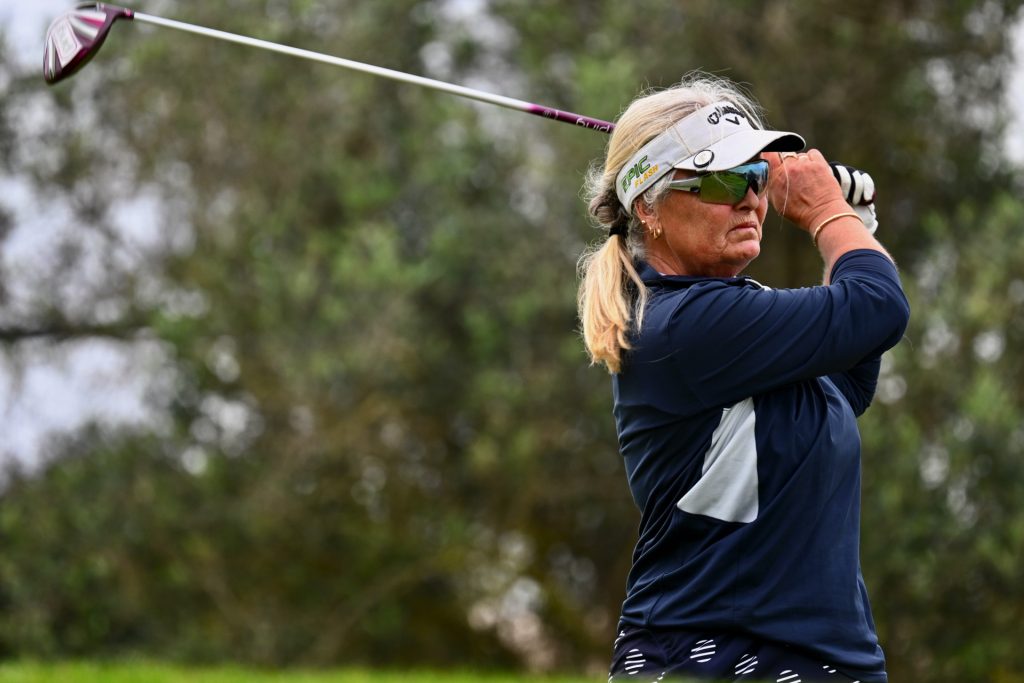
Mette fought hard in the years ahead but by 2000 she had had enough of the excruciating pain and took the decision to have her left eye surgically removed, a prosthetic eye put in place. In 2003, the ache and pain in her remaining eye was at last beaten when she had surgery to create a membrane over the right eye. The downside: vision was replaced by only shadows and bright light, but the pain was then replaced by a feeling of relaxation and peace. To be pain-free after seven years was suddenly “wonderful”, Mette says.
“For me, it was actually a relief to become blind, and it was the right thing for me and my family. I could start living again. As a family, we could now plan and do things when we wanted. It was of course a transition from sighted to blind, but I received great support and help at home. I was able to progress my rehabilitation at the Huseby Center in Oslo. There I learned mobility, ADL (activities of daily living) and Braille. My husband Birger was an incredibly strong support throughout the entire illness and in the time afterwards. I had a desire to go blind to be able to take my life back, so I could start living again, and Birger and the family could enjoy life. It was about quality of life and I have never regretted it. It has led to happy times again.”
Mette enjoyed ballet and gymnastics as a growing girl, and as an adult it was the gym, Crossfit and, like many Norwegians, hiking. Before losing her sight, golf had never entered her mind but 20 years or so later it became front and centre of her thinking.
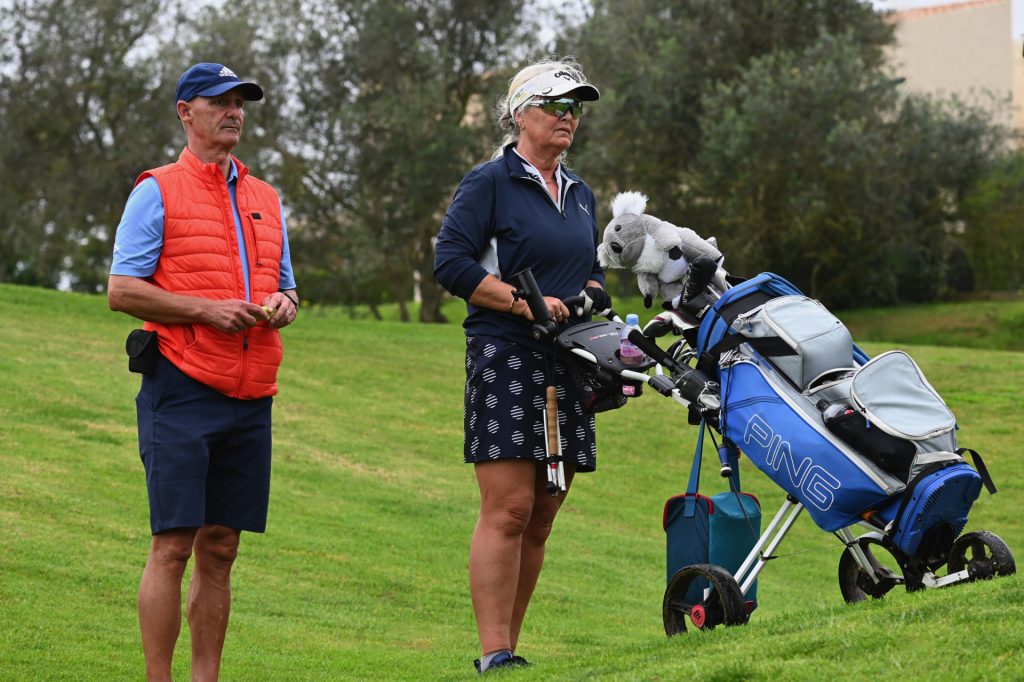
“It was Birger who introduced me to golf in 2019. He had started playing with our youngest son, Sander. When Sander moved out, Birger asked me if I wanted to try it. I did and I found I could hit the ball. Then I signed up for the ‘Way-to-golf’ course at Vestfold Golfklubb and we were off and running. I was now attending a regular golf course with my husband as a companion. Everyone at Vestfold welcomed me well, they were all so good. I was fortunate that Birger was completely hooked on golf too. He thinks it’s a win-win situation for him that I’ve also become hooked. That means more time for golf!”
Mette clearly remembers her first successful hits of the golf ball.
“I started open-minded, and I didn’t know what I’d think. But it was a good feeling, to feel that I hit the ball and that it worked. It was great fun! I found golf after losing my sight and I love it. I am a relatively stubborn person who thinks that anything is possible. I’ve been busy doing the things I did before I went blind – some things now just take a little longer.”
Talking to us with her husband alongside, Birger now adds: “I think the first shot Mette hit well was about 100 yards. That’s when I thought, this really is something we can do together.”
Mette adds: “It’s a wonderful feeling when you hear and feel a good hit [of the ball]. The sound of the ball in the cup is top notch!”
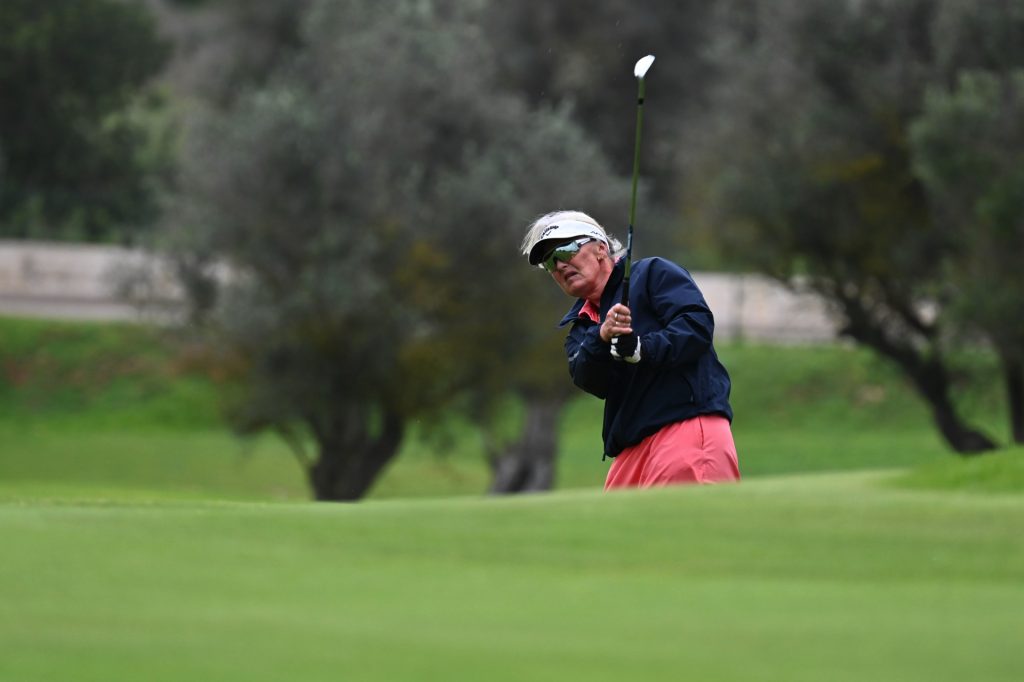
A great many 55-year-olds would be pleased to have a golf handicap of around 22 after playing for only five years, which is Mette’s current status.
Talking with this couple they are quick to laugh together, you can tell they love the game for its fun elements, but Mette says she really appreciates the varied challenges that golf throws at us.
“A round of golf is never the same as your previous round,” Mette adds. “One day everything works, the next day you’re back to square one. At least it feels that way. It is also a sport that means you are outside a lot and Birger and I spend a lot of time together playing golf. We love enjoying the nature around us, that’s really lovely. And I think competition is fun, but unfortunately I can get a little nervous at times.”
A visually impaired golfer relies on a guide who knows their game, their capabilities, and there has to be trust.
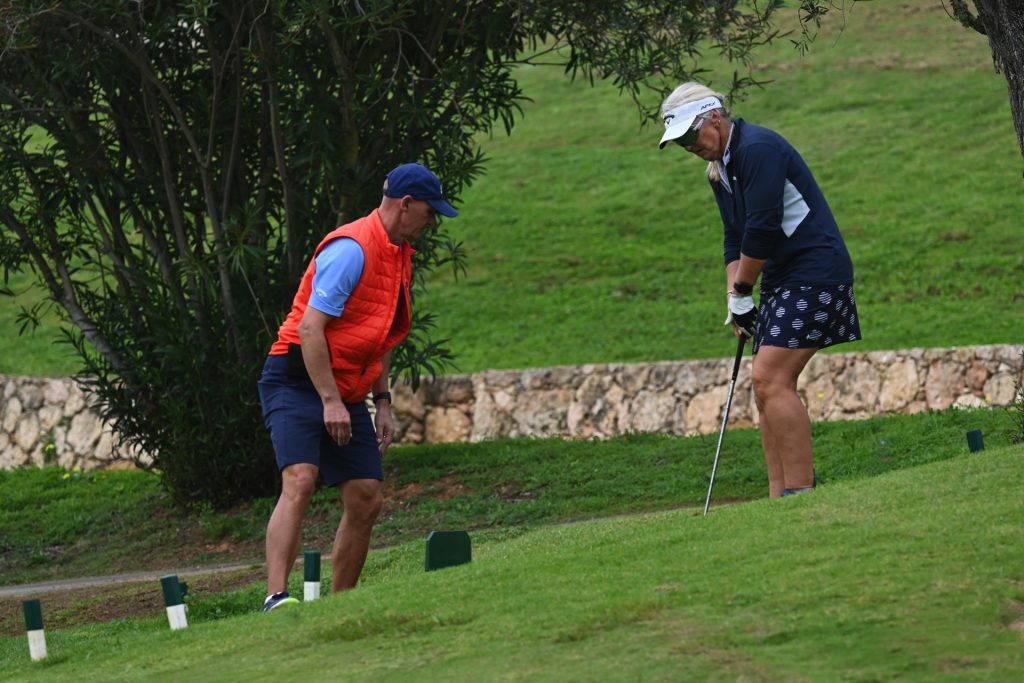
“I depend on Birger to tell me most things on the course. He lines me up in the direction of the pin or desired position, based on the course (the bunkers, water or other obstacles),” explains Mette. “He knows my stroke length well and we agree on the strategy. He sets me up for putting and he is the one who reads the green. We also have a system for how hard/long the putt should be. He is absolutely indispensable on the field.”
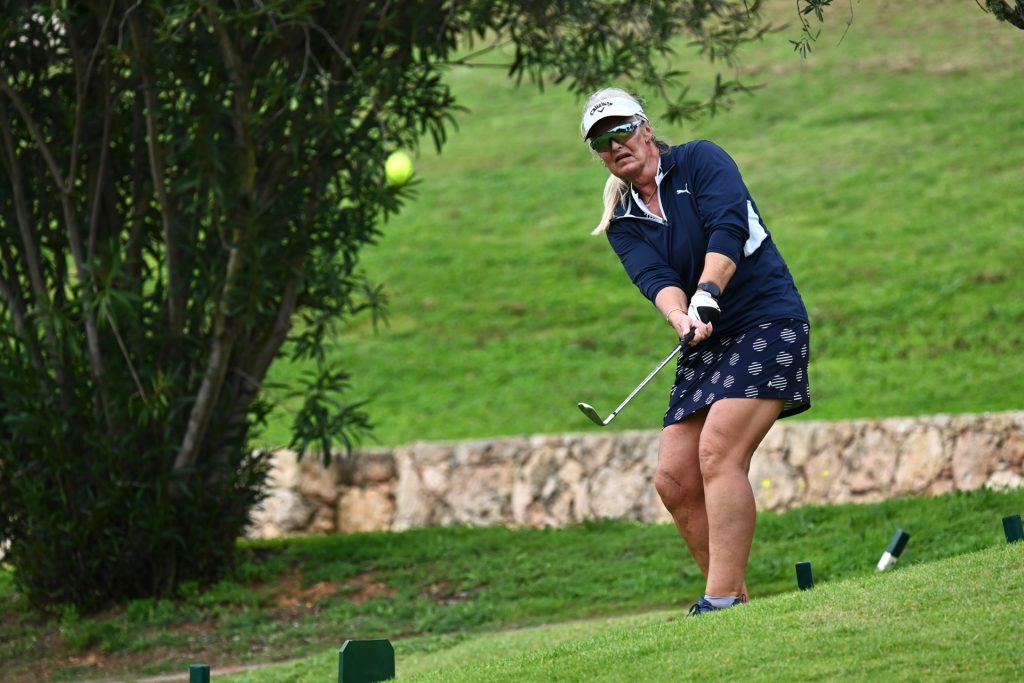
Mette has a feel, from experience, of her home course at Vestfold. Golf courses new to her can be more demanding. She and Birger have to communicate closely on all the shots. Birger has to judge how best to impart all the relevant information on the lay of the land and the dangers to the scorecard, and Mette laughs when she says the whole day can be very tiring. But they still love being out there.
The couple often play together, and they take each other on, and Birger takes his guiding role just as seriously in-between playing his own shots. He says of his own golf: “I’ve played for seven years now. I just love the game, love to be out, and I try to get better and better. It’s great, it’s also the social side of it, obviously the things that we can do together.”
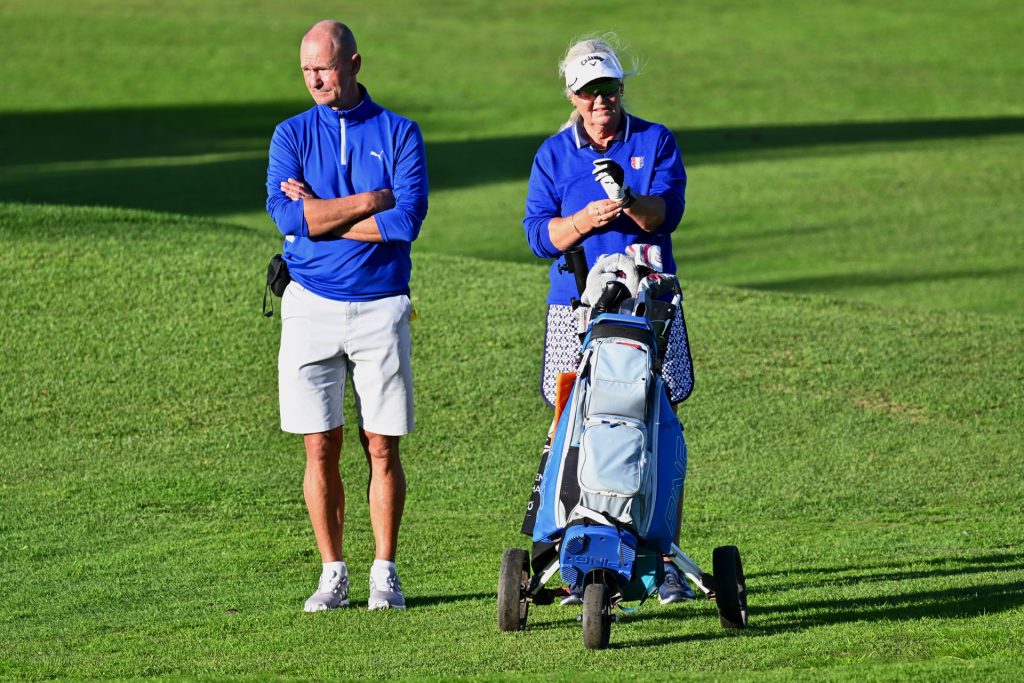
They joke that sometimes she will blame him for “lining me up incorrectly” when she does a bad shot, or if he misreads the greens, but you can tell from their laughter that such disagreement is for fun, in reality the dynamic is steeped in trust and a joy for play. “Yes, it feels like we are a team, every step of the way. The more Birger can help me, the better we can score out there and the more we learn about the game,” agrees Mette.
She adds: “We have an apartment in Spain and we take part in tournaments there. We also play tournaments with Norwegian Senior Golf. There has never been any problem when we sign up for events and ask to go on the same flight on the course. Everyone makes arrangements for us. I am always well received.”
EDGA is the organisation that runs, badges or supports 120 international G4D tournaments in a year, and after playing one of these in Norway in 2022, Mette was keen to also travel to play, realising this objective this January (2024) by playing back-to-back EDGA Algarve events in Portugal. Mette was delighted to experience the welcoming and inclusive atmosphere among the G4D players here.
“Yes I liked the social side very much. It’s difficult for me to make contact with people. I was very impressed when we were making arrangements and when we arrived, how people contacted me and engaged with me. They were very inclusive. I’m not the one who can go and find people and introduce myself, so they have to find me, and they were all very good.”
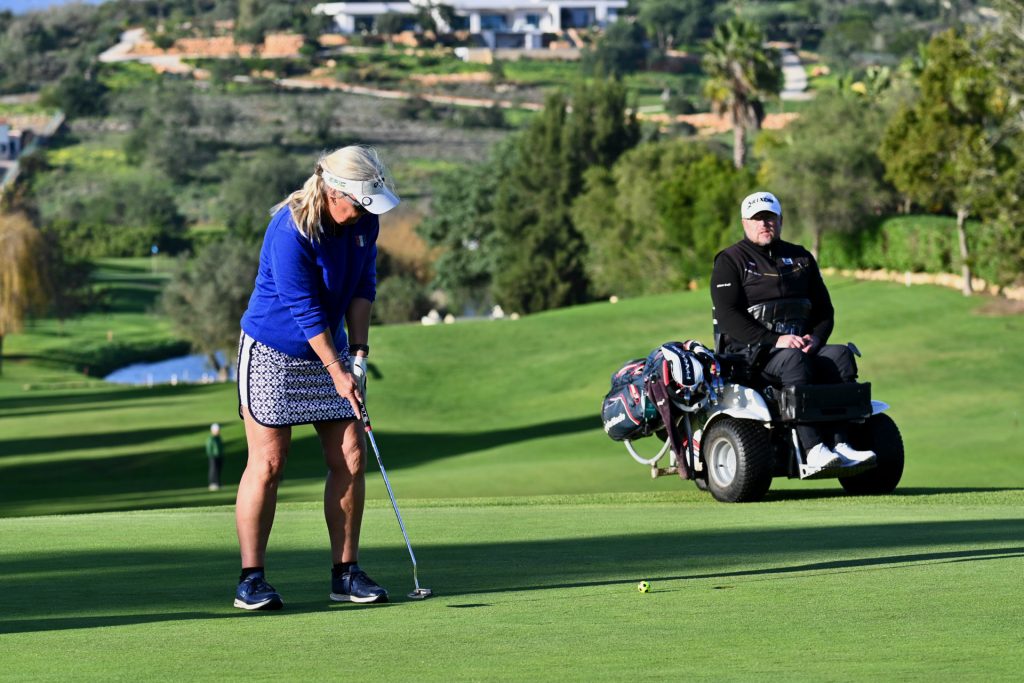
Looking forwards, Mette would like to play her part in helping make golf more accessible for the visually impaired, and get more people into the sport.
Gordon Morrison, the Head Professional at Vestfold GK, coached Mette and after consulting with EDGA coaching specialists Mark Taylor and Tony Bennett he adapted the ‘Way to Golf’ course for new players to support the visually impaired. Mette’s experience as a new player got Gordon thinking and he devised a coaching method to take out the usual visual stimuli of a lesson, using instead creativity and careful thought around verbal communication and, with the help of the golfer’s guide, helping to position the player via advice. Gordon’s foresight and innovation helped Mette and can help others too.
Mette added: “I have also been to Kristiansand GK and participated in an event for the visually impaired. I am also in contact with all at Kongsvinger about communicating my experience as a golfer to a group of visually impaired people there. I hope it contributes to more visually impaired people discovering the joys of golf. Many people are surprised when they hear that I play golf and they have trouble understanding how that is possible. They are surprised and impressed when they see how we work together and make it work on the course.”
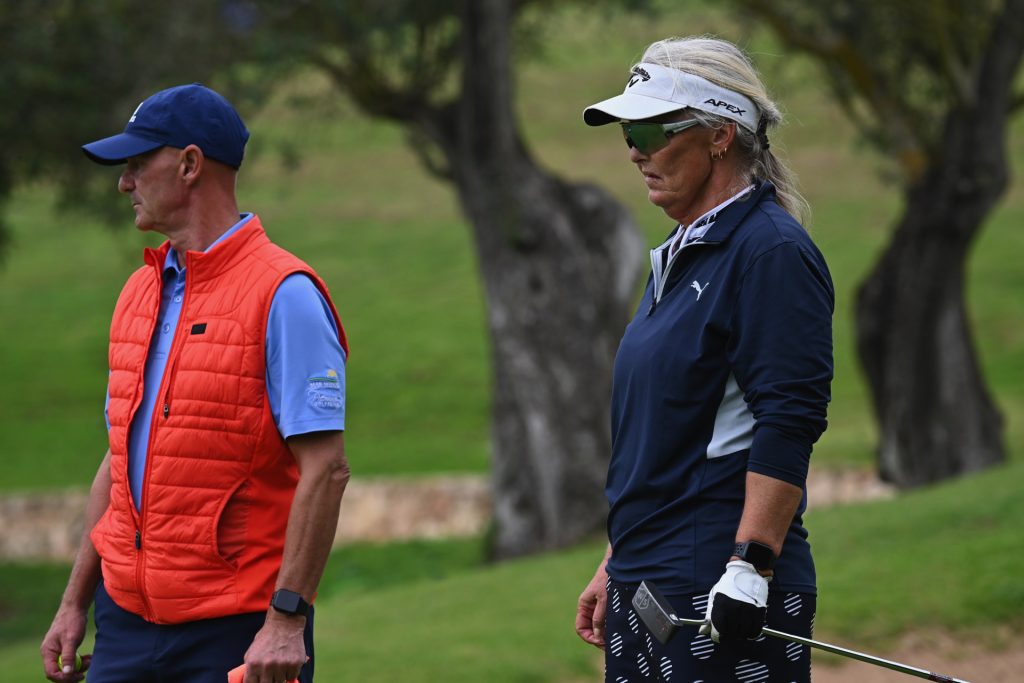
Norway is making great strides in G4D. EDGA’s Head of Instruction and Education Mark Taylor has made two visits to Norway in recent years, training more than 40 volunteer coaches to help more people with disability to take up the game. Mark tells us: “In both my visits I have been struck by how well the Norwegian Golf Federation and the nation’s PGA work together to make golf a more inclusive sport for new players. The Federation’s Lead Gøril Hansen has been fantastic in creating this ‘can-do’ attitude and has been instrumental in welcoming new players with impairment to G4D. Our EDGA team were all delighted to learn Mette was competing in our two events in Portugal recently and we hope to meet her at further tournaments.”
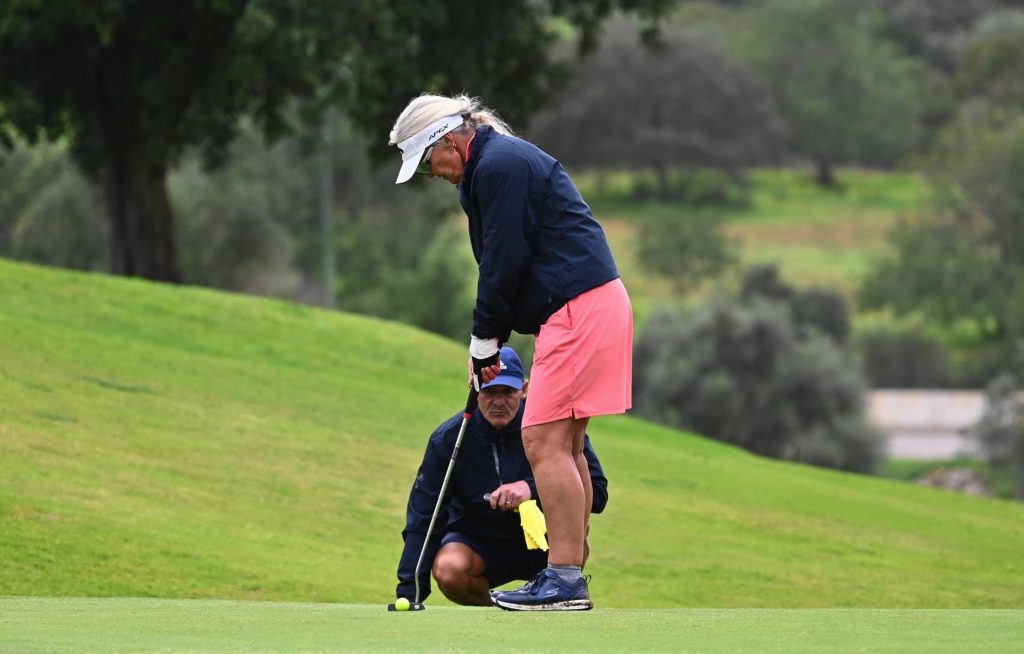
Mette adds: “I would definitely recommend the visually impaired to try golf. It is a great sport where you can challenge yourself. It is a social sport where you meet many nice people. It is good exercise and you are outside a lot. It is also a sport where we can compete against everyone, disabled and able-bodied. Everyone against everyone with their golf handicap.”
Meanwhile, Birger is emphatic that he has derived a great deal of satisfaction and feels a sense of pride in supporting Mette as a guide. He would urge others to consider helping golfers with a visual impairment in this way.
“It’s very satisfying and I have no doubt it has made me a better golfer, because I’m reading the greens a lot more than if I was only playing for myself. You begin thinking more about layups or how to go for the flag, you are thinking a little bit more when you’re a caddie and a guide. So I think that’s been helping me too. But obviously, I’m proud when Mette is playing. I am here to help her.”
Birger and Mette are indeed a team, and have good days and bad days with the scorecard together, but they love the game far more than simply for the scores, points or prizes. The shared experience they have built through marriage, family, but later all through Mette’s illness and the happy times since, through the winding tracks over the mountains, to the thousands of fairways and greens, is surely remarkable. It clearly comes from being a team, and from love.
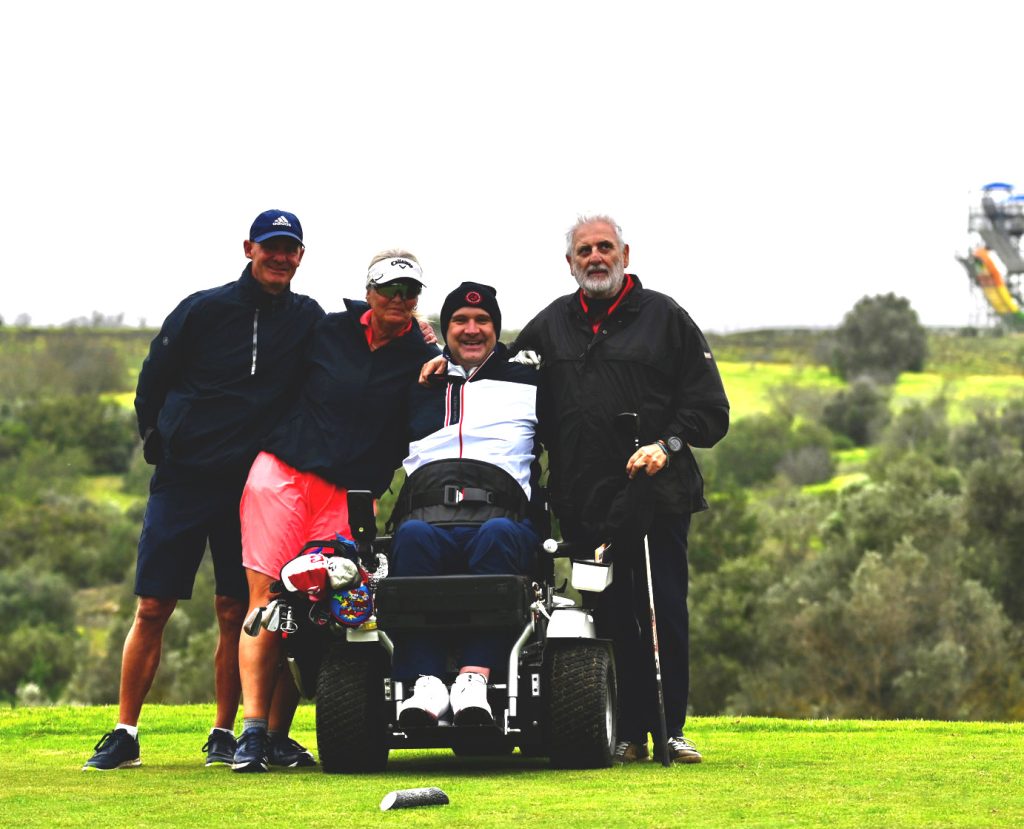
NB: When using any EDGA media, please comply with our copyright conditions


